check transmission fluid OLDSMOBILE BRAVADA 1998 Owners Manual
[x] Cancel search | Manufacturer: OLDSMOBILE, Model Year: 1998, Model line: BRAVADA, Model: OLDSMOBILE BRAVADA 1998Pages: 380, PDF Size: 19.2 MB
Page 188 of 380

Hill and Mountain Roads
Driving on steep hills or mountains is different from
driving in flat or rolling terrain.
If
you drive regularly in steep country, or if you're
planning to visit there, here are some tips that
can make
your trips safer and more enjoyable. (See "Off-Road
Driving" in the Index
for information about driving
off-road.)
0
0
Keep your vehicle in good shape. Check all fluid
levels and
also the brakes, tires, cooling system and
transmission. These
parts can work hard on
mountain roads.
Know how to
go down hills. The most important
thing to know is this: let
your engine do some of the
slowing down. Shift to a lower gear when
you go
down a steep or long hill.
If you don't shift down, your brakes could get
so hot that they wouldn't work well. You would
then have poor braking or even none going
down
a hill. You could crash. Shift down to let
your engine assist your brakes on
a steep I
1 downhill slope.
4-36
ProCarManuals.com
Page 204 of 380

When You Are Ready to Leave After
Parking
on a Hill
1. Apply your regular brakes and hold the pedal down
while you:
Start your engine;
0 Shift into a gear; and
0 Release the parking brake.
2. Let up on the brake pedal.
3. Drive slowly until the trailer is clear of the chocks.
4. Stop and have someone pick up and store the chocks.
Maintenance When Trailer Towing
Your vehicle will need service more often when you’re
pulling
a trailer. See the Maintenance Schedule for more
on this. Things that are especially important in trailer
operation are automatic transmission fluid (don’t
overfill). engine
oil. axle lubricant, belt, cooling system
and brake adjustment. Each
of these is covered in this
manual, and‘the Index will help you
find them quickly.
If you’re trailering, it’s a good idea to review these
sections before you start your trip.
Check periodically to see that all hitch nuts and bolts
are tight
,
4-52
ProCarManuals.com
Page 243 of 380
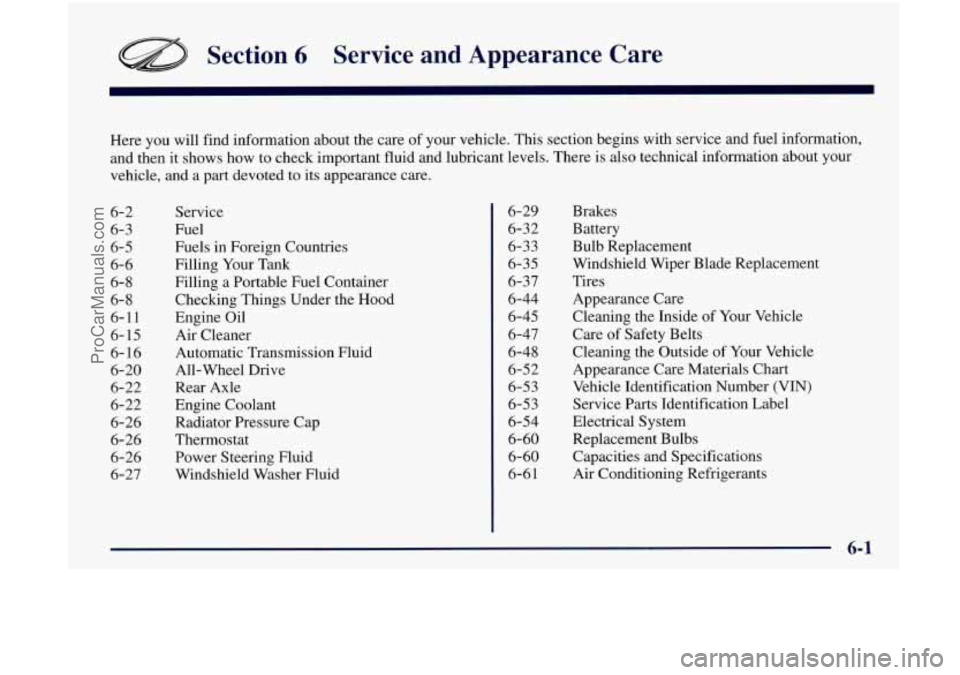
Section 6 Service and Appearance Care
Here you will find information about the care of your vehicle. This section begins with service and fuel information,
and then it shows how to check important fluid and lubricant levels. There is also t\
echnical information about your
vehicle, and a part devoted to its appearance care.
6-2
6- 3
6-5
6-6
6-8
6-8
6-11
6- 15
6- 16
6-20
6-22
6-22
6-26
6-26
6-26 6-27 Service
Fuel
Fuels in Foreign Countries
Filling Your Tank
Filling a Portable Fuel Container
Checking Things Under the
Hood
Engine Oil
Air Cleaner
Automatic Transmission Fluid
All-Wheel Drive
Rear Axle
Engine Coolant Radiator Pressure Cap
Thermostat
Power Steering Fluid
Windshield Washer Fluid
6-29
6-32
6-33
6-35
6-37
6-44
6-45
6-47
6-48
6-52
6-53
6-53
6-54
6-60 6-60
6-6
1
Brakes
Battery
Bulb Replacement
Windshield Wiper Blade Replacement
Tires Appearance Care
Cleaning the Inside of Your Vehicle
Care
of Safety Belts
Cleaning the Outside of Your Vehicle
Appearance Care Materials Chart
Vehicle Identification Number (VIN)
Service Parts Identification Label
Electrical System
Replacement Bulbs
Capacities and Specifications
Air Conditioning Refrigerants
ProCarManuals.com
Page 258 of 380
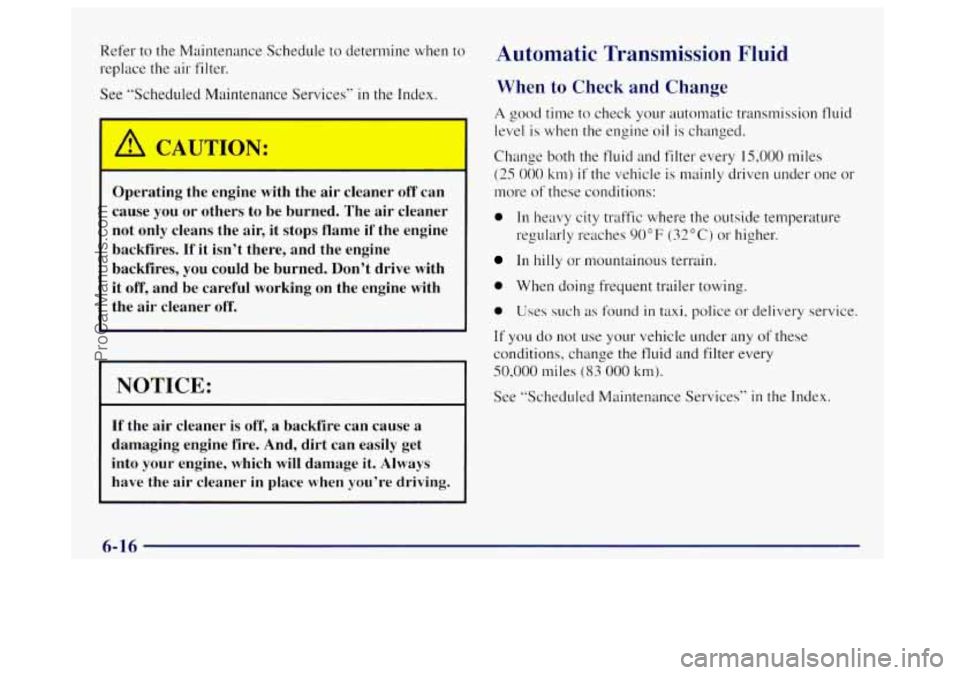
Refer to the Maintenance Schedule to determine when to
replace the air filter.
See “Scheduled Maintenance Services”
in the Index.
Operating the engine with the air cleaner off can
cause you or others to be burned. The air cleaner
not only cleans the air, it stops flame
if the engine
backfires.
If it isn’t there, and the engine
backfires,
you could be burned. Don’t drive with
it off, and be careful working on the engine with
the air cleaner off.
I NOTICE:
If the air cleaner is off, a backfire can cause a
damaging engine fire. And, dirt can easily get
into your engine, which will damage
it. Always
have the air cleaner in place when you’re driving.
Automatic Transmission Fluid
When to Check and Change
A good time to check your automatic transmission fluid
level
is when the engine oil is changed.
Change both the fluid and filter every
15,000 miles
(25
000 km) if the vehicle is mainly driven under one or
more
of these conditions:
0 In heavy city traffic where the outside temperature
regularly reaches
90°F (32°C) or higher.
In hilly or mountainous terrain.
0 When doing frequent trailer towing.
0 Uses such as found in taxi, police or delivery service.
If you do not use your vehicle under any of these
conditions, change the
fluid and filter every
50,000 miles (83 000 km).
See ”Scheduled Maintenance Services” in the Index.
6-16
ProCarManuals.com
Page 259 of 380

How to Check
Because this operation can be a little difficult, you may
choose
to have this done at your GM retail facility
Service Department.
If you do it yourself, be sure to follow all the
instructions here, or you could get a false reading on
the dipstick.
NOTICE:
Too much or too little fluid can damage your
transnlission.
Too much can mean that some of
the fluid could come out and fall on hot engine
parts or exhaust system parts, starting a fire. Be
sure to get an accurate reading if you check your
transmission fluid.
Wait at least 30 minutes before checking the
transmission fluid level
if you have been driving:
0 When outside temperatures are above 90°F (32°C).
0 At high speed for quite a while.
0 In heavy traffic -- especially in hot weather.
While pulling a trailer.
To get the right reading, the fluid should be at normal
operating temperature, which is
180°F to 200°F (82°C
to 93°C). See "Checking Transmission Fluid Hot" in
the Index.
Checking Transmission Fluid Hot
Get the vehicle warmed up by driving about 15 miles
(24 km) when outside temperatures are above 50°F
(10°C). If it's colder than 50°F (IOOC), drive the
vehicle
in THIRD (3) until the engine temperature gage
moves and then remains steady for
10 minutes. Then
follow the hot check procedures.
ProCarManuals.com
Page 260 of 380

Checking Transmission Fluid Cold
A cold check is made after the vehicle has been sitting
for eight hours or more
with the engine off and is used
only as a reference. Let the engine run at idle for five
minutes
if outside temperatures are 50°F (10°C) or
more. If it's colder than
50°F (lO"C), you may have to
idle the engine longer. Should the fluid level be low
during
a cold check, you must perform a hot check
before adding fluid. This will give you a more accurate
reading of the fluid level.
Checking the Fluid Hot or Cold
Park your vehicle on a level place. Keep the
engine running.
With the parking brake applied, place the shift lever
in
PARK (P).
With your foot on the brake pedal, move the shift
lever through each gear range, pausing for about
three seconds
in each range. Then, position the shift
lever in PARK (P).
0 Let the engine run at idle for three minutes or more. Then,
without shutting off the engine, follow
these steps:
I. Flip the handle up
and then pull out
the dipstick and
wipe it
with a clean
rag or paper towel.
2. Push it back in all the way, wait three seconds and
then
pull it back out again.
6-18
ProCarManuals.com
Page 261 of 380

How to Add Fluid
3. Check both sides of the dipstick, and read the lower
level. The fluid level must be in the COLD area for a
cold check or in the HOT area or cross-hatched area
for a hot check.
4. If the fluid level is in the acceptable range, push the
dipstick back in all the way; then flip the handle
down to lock the dipstick in place. Refer to the Maintenance Schedule to determine
what
kind
of transmission fluid to use. See “Recommended
Fluids and Lubricants’’ in the Index.
Add fluid only after checking the transmission fluid
while it is hot. (A cold check is used only as a
reference.) If the fluid level is low, add only enough
of
the proper fluid to bring the level up to the HOT area for
a hot check. It doesn’t take much fluid, generally less
than one pint
(0.5 L). Don’t overJiZ1.
NOTICE:
We recommend you use only fluid labeled
DEXR0N’-III, because fluid with that label is
made especially for your automatic transmission.
Damage caused by fluid other than
DEXRON-ZLI
is not covered by your new vehicle warranty.
0 After adding fluid, recheck the fluid level as
described under “How to Check.”
When the correct fluid level is obtained, push the
dipstick back in all the
way; then flip the handle
down to lock the dipstick in place.
6-19
ProCarManuals.com
Page 303 of 380
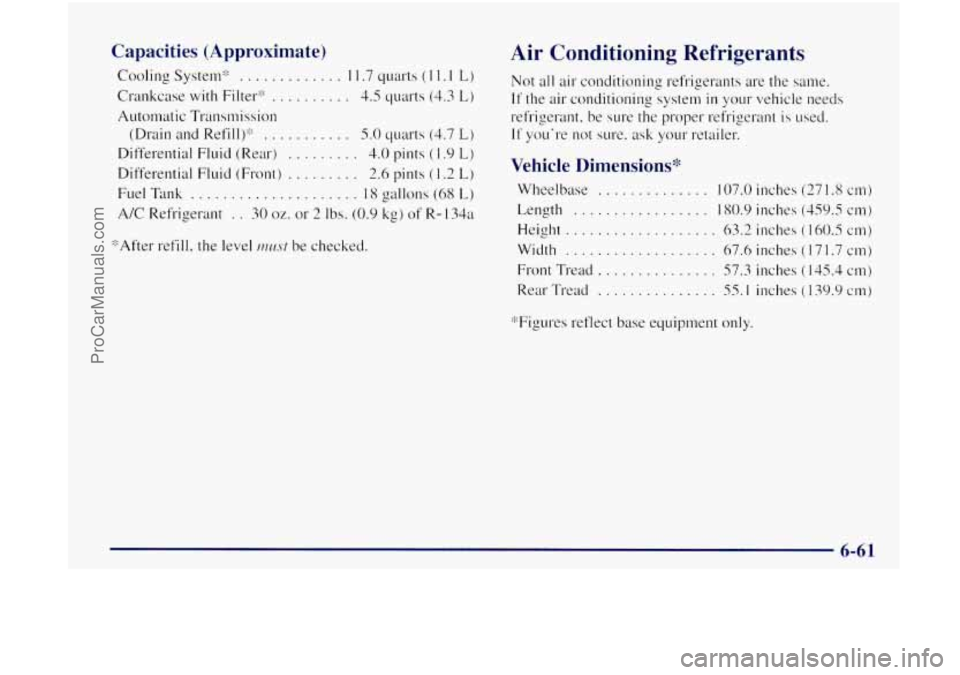
Capacities (Approximat-e)
Cooling System'" ............. 1 1.7 quarts (1 I, I L)
Crankcase with Filter'" .......... 4.5 quarts (4.3 L)
Automatic Transmission
(Drain and Refill):':
........... 5.0 quarts (4.7 L)
Differential Fluid (Rear) ......... 4.0 pints ( I .9 L)
Differential Fluid (Front) ......... 2.6 pints ( 1.2 L)
Fuel Tank ..................... 18 gallons (68 L)
A/C Refrigerant . . 30 oz. or 2 Ibs. (0.9 kg) of R- 13421
'"After refill, the level
m~st be checked.
Air Conditioning Refrigerants
Not all air conditioning refrigerants are the same.
If the air conditioning system in your vehicle needs
refrigerant. be
SLIE the proper refrigerant is sed.
I1 you're not sure. ask your retailer.
Vehicle Dimensions*
Wheelbase .............. 107.0 inches (27 1.8 cm)
Length ................. 180.9 inches (459.5 cm)
Height
................... 63.2 inches ( 160.5 cm)
Width ................... 67.6 inches ( 17 1.7 an)
Front Tread
............... 57.3 inches ( 145.4 cm)
Rear Tread ............... 55.1 inches ( 139.9 cm)
'"Figures reflect base equipment only.
6-61
ProCarManuals.com
Page 314 of 380
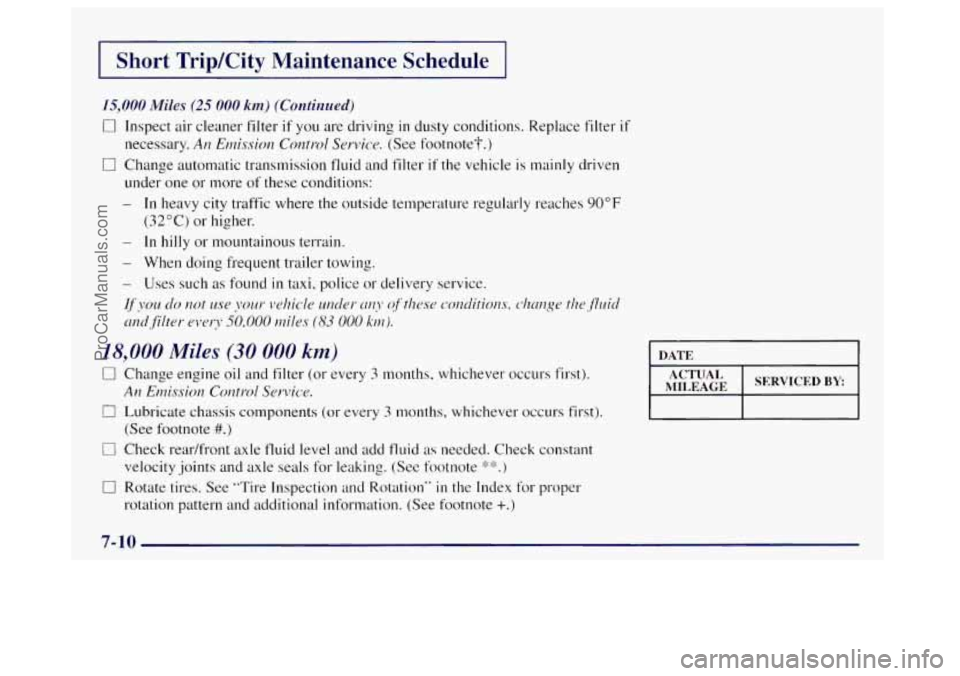
I Short Trip/City Maintenance Schedule 1
I.5,OOO Miles (25 000 km) (Continued)
0 Inspect air cleaner filter if you are driving in dusty conditions. Replace filter if
necessary. An Emissiolz Control Service. (See footnote?.)
0 Change automatic transmission fluid and filter if the vehicle is mainly driven
under one or more
of these conditions:
- In heavy city traffic where the outside temperature regularly reaches 90°F
- In hilly or mountainous terrain.
- When doing frequent trailer towing.
- Uses such as found in taxi, police or delivery service.
If !?ou cIo rzof LW ~OUP' vehicle under uny of these conditior1s, chrzge tize,flrrid
crnclfilter. ever~? 50,000 miles (83 000 knl).
(32°C) or higher.
18,000 Miles (30 000 km)
0 Change engine oil and filter (or every 3 months, whichever occurs first).
0 Lubricate chassis components (or every 3 months, whichever occurs first).
0 Check readfront axle fluid level and add fluid as needed. Check constant
0 Rotate tires. See "Tire Inspection and Rotation" in the Index for proper
An Emission Control Service.
(See footnote #.)
velocity .joints and axle seals for leaking. (See footnote 'K'k.)
rotation pattern and additional information. (See footnote +.)
DATE
SERVICED
BY
7-10
ProCarManuals.com
Page 316 of 380
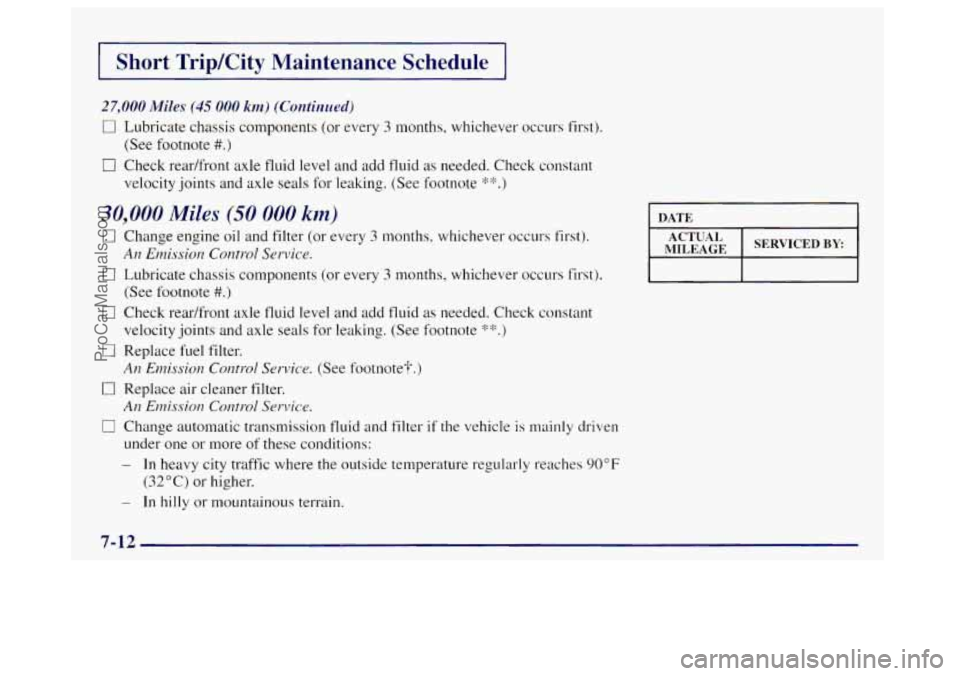
I Short TripKity Maintenance Schedule I
27,000 Miles (45 000 km) (Continued)
0 Lubricate chassis components (or every 3 months, whichever occurs first).
0 Check readfront axle fluid level and add fluid as needed. Check constant
(See
footnote
#.)
velocity joints and axle seals for leaking. (See footnote +'+'.)
30,000 Miles (50 000 km)
0 Change engine oil and filter (or every 3 months, whichever occurs first).
0 Lubricate chassis components (or every 3 months, whichever occurs first).
(See footnote
#.)
0 Check rear/front axle fluid level and add fluid as needed. Check constant
velocity joints and axle seals
for leaking. (See footnote a:*.)
0 Replace fuel filter.
An Emission Control Service. (See footnote-1.)
0 Replace air cleaner filter.
An Emission Control Service.
0 Change automatic transmission fluid and filter if the vehicle is mainly driven
under one
01- more of these conditions:
- In heavy city traffic where the outside temperature regularly reaches 90°F
- In hilly or mountainous terrain.
An Emission Control Service.
(32°C) or higher.
DATE 1
SERVICED BY
7-12
ProCarManuals.com